Semantic Segmentation of 3D Point Clouds Based on High Precision Range Search Network
Abstract
1. Introduction
2. Methods
2.1. Set Abstraction Layer
2.1.1. Sampling Layer
- (1)
- Assuming the input point clouds contain N points, select point P0 from the point cloud as the initial point to obtain the sampling point set as S = {P0}.
- (2)
- Calculate and store in the array L the distance from the rest points containing (N − 1) points to P0. The sample point set is then updated to S = {P0, P1} by selecting the point corresponding to the maximum value in array L as P1.
- (3)
- Calculate the distance from the rest point containing (N − 2) points to P1. If the distance from the rest point Pi to P1 is less than L[i], update L[i] = d(Pi, P1). Then select the point corresponding to the maximum value in L as P2, update S = {P0, P1, P2}.
- (4)
- Repeat steps 2–3 until the required number of sampling points has been reached.
2.1.2. Grouping Layer
2.1.3. Improved PointNet Layer
2.2. Feature Propagation Layer
3. Validation
3.1. Benchmark Methods
3.2. Evaluation Metrics
4. Experiment
4.1. Dataset
4.2. Experiment Settings
4.3. Results and Discussion
5. Conclusions
Author Contributions
Funding
Data Availability Statement
Acknowledgments
Conflicts of Interest
References
- Hackel, T.; Wegner, J.D.; Schindler, K. Fast semantic segmentation of 3D point clouds with strongly varying density. ISPRS Ann. Photogramm. Remote Sens. Spat. Inf. Sci. 2016, 3, 177–184. [Google Scholar] [CrossRef]
- Xu, Y.; Tong, X.; Stilla, U. Voxel-based representation of 3D point clouds: Methods, applications, and its potential use in the construction industry. Automat. Constr. 2021, 126, 103675. [Google Scholar] [CrossRef]
- Guo, Y.; Wang, H.; Hu, Q.; Liu, H. Deep learning for 3d point clouds: A survey. IEEE Trans. Pattern Anal. Mach. Intell. 2020, 43, 4338–4364. [Google Scholar] [CrossRef]
- Yan, X.; Zheng, C.; Li, Z.; Wang, S.; Cui, S. Pointasnl: Robust point clouds processing using nonlocal neural networks with adaptive sampling. In Proceedings of the IEEE/CVF Conference on Computer Vision and Pattern Recognition (CVPR), Seattle, WA, USA, 13–19 June 2020; pp. 5589–5598. [Google Scholar]
- Chen, X.T.; Li, Y.; Fan, J.H.; Wang, R. RGAM: A novel network architecture for 3D point cloud semantic segmentation in indoor scenes. Inform. Sci. 2021, 571, 87–103. [Google Scholar] [CrossRef]
- Wang, L.; Huang, Y.; Hou, Y.; Zhang, S.; Shan, J. Graph attention convolution for point cloud semantic segmentation. In Proceedings of the IEEE/CVF Conference on Computer Vision and Pattern Recognition (CVPR), Long Beach, CA, USA, 15–20 June 2019; pp. 10296–10305. [Google Scholar]
- Qin, N.; Hu, X.; Dai, H. Deep fusion of multi-view and multimodal representation of ALS point cloud for 3D terrain scene recognition. ISPRS J. Photogramm. Remote Sens. 2018, 143, 205–212. [Google Scholar] [CrossRef]
- Song, S.; Xiao, J. Deep sliding shapes for amodal 3d object detection in rgb-d images. In Proceedings of the IEEE Conference on Computer Vision and Pattern Recognition (CVPR), Las Vegas, NV, USA, 27–30 June 2016; pp. 808–816. [Google Scholar]
- Yin, C.; Wang, B.; Gan, V.J.L.; Wang, M.; Cheng, J.C.P. Automated semantic segmentation of industrial point clouds using ResPointNet++. Automat. Constr. 2021, 130, 103874. [Google Scholar] [CrossRef]
- Engelmann, F.; Kontogianni, T.; Hermans, A.; Leibe, B. Exploring spatial context for 3D semantic segmentation of point clouds. In Proceedings of the IEEE International Conference on Computer Vision Workshops (ICCVW), Venice, Italy, 22–29 October 2017; pp. 716–724. [Google Scholar]
- Qi, X.; Liao, R.; Jia, J.; Fidler, S.; Urtasun, R. 3d graph neural networks for rgbd semantic segmentation. In Proceedings of the IEEE International Conference on Computer Vision (ICCV), Venice, Italy, 22–29 October 2017; pp. 5199–5208. [Google Scholar]
- Guerry, J.; Boulch, A.; Saux, B.L.; Moras, J.; Plyer, A.; Filliat, D. SnapNet-R: Consistent 3D Multi-view Semantic Labeling for Robotics. In Proceedings of the IEEE International Conference on Computer Vision (ICCV), Venice, Italy, 22–29 October 2017; pp. 669–678. [Google Scholar]
- Hu, Z.; Bai, X.; Shang, J.; Zhang, R.; Dong, J.; Wang, X.; Sun, G. Vmnet: Voxel-mesh network for geodesic-aware 3d semantic segmentation. In Proceedings of the IEEE/CVF International Conference on Computer Vision (ICCV), Montreal, QC, Canada, 10–17 October 2021; pp. 15488–15498. [Google Scholar]
- Hu, Q.; Yang, B.; Xie, L.; Rosa, S.; Guo, Y.; Wang, Z.; Trigoni, N.; Markham, A. Randla-net: Efficient semantic segmentation of large-scale point clouds. In Proceedings of the IEEE/CVF Conference on Computer Vision and Pattern Recognition (CVPR), Seattle, WA, USA, 13–19 June 2020; pp. 11108–11117. [Google Scholar]
- Su, H.; Maji, S.; Kalogerakis, E.; Learned-Miller, E. Multi-view Convolutional Neural Networks for 3D Shape Recognition. In Proceedings of the IEEE International Conference on Computer Vision (ICCV), Santiago, Chile, 7–13 December 2015; pp. 945–953. [Google Scholar]
- Badrinarayanan, V.; Kendall, A.; Cipolla, R. Segnet: A deep convolutional encoder-decoder architecture for image segmentation. IEEE Trans. Pattern Anal. Mach. Intell. 2017, 39, 2481–2495. [Google Scholar] [CrossRef] [PubMed]
- Kalogerakis, E.; Averkiou, M.; Maji, S.; Chaudhuri, S. 3D Shape Segmentation with Projective Convolutional Networks. In Proceedings of the IEEE Conference on Computer Vision and Pattern Recognition (CVPR), Honolulu, HI, USA, 21–26 July 2017; pp. 3779–3788. [Google Scholar]
- Kundu, A.; Yin, X.; Fathi, A.; Ross, D.; Brewington, B.; Funkhouser, T.; Pantofaru, C. Virtual multi-view fusion for 3d semantic segmentation. In Proceedings of the 16th European Conference on Computer Vision, Glasgow, UK, 23–28 August 2020; pp. 518–535. [Google Scholar]
- Tchapmi, L.P.; Choy, C.B.; Armeni, I.; Gwak, J.Y.; Savarese, S. SEGCloud: Semantic Segmentation of 3D Point Clouds. In Proceedings of the IEEE Conference on Computer Vision and Pattern Recognition (CVPR), Honolulu, HI, USA, 21–26 July 2017; pp. 537–547. [Google Scholar]
- Riegler, G.; Ulusoy, A.O.; Geiger, A. Octnet: Learning deep 3d representations at high resolutions. In Proceedings of the IEEE Conference on Computer Vision and Pattern Recognition (CVPR), Honolulu, HI, USA, 21–26 July 2017; pp. 3577–3586. [Google Scholar]
- Graham, B.; Engelcke, M.; Maaten, L.V.D. 3d semantic segmentation with submanifold sparse convolutional networks. In Proceedings of the IEEE/CVF Conference on Computer Vision and Pattern Recognition, Salt Lake City, UT, USA, 18–22 June 2018; pp. 9224–9232. [Google Scholar]
- Meng, H.Y.; Gao, L.; Lai, Y.K.; Manocha, D. Vv-net: Voxel vae net with group convolutions for point cloud segmentation. In Proceedings of the IEEE/CVF International Conference on Computer Vision (ICCV), Seoul, Korea, 27 October–2 November 2019; pp. 8500–8508. [Google Scholar]
- Qi, C.R.; Su, H.; Mo, K.; Guibas, L.J. PointNet: Deep Learning on Point Sets for 3D Classification and Segmentation. In Proceedings of the IEEE Conference on Computer Vision and Pattern Recognition (CVPR), Honolulu, HI, USA, 21–26 July 2017; pp. 652–660. [Google Scholar]
- Qi, C.R.; Yi, L.; Su, H.; Guibas, L.J. PointNet++: Deep Hierarchical Feature Learning on Point Sets in a Metric Space. In Proceedings of the IEEE Conference on Computer Vision and Pattern Recognition (CVPR), Honolulu, HI, USA, 21–26 July 2017; p. 30. [Google Scholar]
- Li, Y.; Bu, R.; Sun, M.; Wu, W.; Di, X.; Chen, B. PointCNN: Convolution On X-Transformed Points. In Proceedings of the IEEE/CVF Conference on Computer Vision and Pattern Recognition, Salt Lake City, UT, USA, 18–22 June 2018; p. 31. [Google Scholar]
- Jiang, M.; Wu, Y.; Zhao, T.; Zhao, Z. Pointsift: A sift-like network module for 3d point cloud semantic segmentation. In Proceedings of the IEEE/CVF Conference on Computer Vision and Pattern Recognition, Salt Lake City, UT, USA, 18–22 June 2018. [Google Scholar]
- Wang, Y.; Sun, Y.; Liu, Z.; Sarma, S.E.; Bronstein, M.M.; Solomon, J.M. Dynamic Graph CNN for Learning on Point Clouds. ACM Trans. Graph. 2019, 38, 1–12. [Google Scholar] [CrossRef]
- Lang, I.; Manor, A.; Avidan, S. Samplenet: Differentiable point cloud sampling. In Proceedings of the IEEE/CVF Conference on Computer Vision and Pattern Recognition (CVPR), Seattle, WA, USA, 13–19 June 2020; pp. 7578–7588. [Google Scholar]
- Moenning, C.; Dodgson, N.A. A new point cloud simplification algorithm. In Proceedings of the 3rd IASTED International Conference on Visualization, Imaging, and Image Processing (VIIP 2003), Benalmádena, Spain, 8–10 September 2003; pp. 1027–1033. [Google Scholar]
- Fan, H.; Yang, Y. PointRNN: Point recurrent neural network for moving point cloud processing. In Proceedings of the IEEE/CVF Conference on Computer Vision and Pattern Recognition (CVPR), Long Beach, CA, USA, 15–20 June 2019. [Google Scholar]
- Xie, X.; Zhang, W.; Wang, H.; Li, L.; Feng, Z.; Wang, Z.; Wang, Z.; Pan, X. Dynamic adaptive residual network for liver CT image segmentation. Comput. Electr. Eng. 2021, 91, 107024. [Google Scholar] [CrossRef]
- Li, B.; Lima, D. Facial expression recognition via ResNet-50. Int. J. Cogn. Comput. Eng. 2021, 2, 57–64. [Google Scholar] [CrossRef]
- Song, Z.; Liu, Y.; Song, R.; Chen, Z.; Yang, J.; Zhang, C.; Jiang, Q. A sparsity-based stochastic pooling mechanism for deep convolutional neural networks. Neural Netw. 2018, 105, 340–345. [Google Scholar] [CrossRef] [PubMed]
- Li, Y.; Zhang, X.; Chen, D. Csrnet: Dilated convolutional neural networks for understanding the highly congested scenes. In Proceedings of the IEEE/CVF Conference on Computer Vision and Pattern Recognition, Salt Lake City, UT, USA, 18–22 June 2018; pp. 1091–1100. [Google Scholar]
- Mei, G.; Xu, L.; Xu, N. Accelerating adaptive inverse distance weighting interpolation algorithm on a graphics processing unit. R. Soc. Open Sci. 2017, 4, 170436. [Google Scholar] [CrossRef] [PubMed]
- Lu, G.Y.; Wong, D.W. An adaptive inverse-distance weighting spatial interpolation technique. Comput. Geosci. 2008, 34, 1044–1055. [Google Scholar] [CrossRef]
- Tatarchenko, M.; Park, J.; Koltun, V.; Zhou, Q. Tangent convolutions for dense prediction in 3d. In Proceedings of the IEEE/CVF Conference on Computer Vision and Pattern Recognition, Salt Lake City, UT, USA, 18–22 June 2018; pp. 3887–3896. [Google Scholar]
- Huang, Q.; Wang, W.; Neumann, U. Recurrent slice networks for 3d segmentation of point clouds. In Proceedings of the IEEE/CVF Conference on Computer Vision and Pattern Recognition, Salt Lake City, UT, USA, 18–22 June 2018; pp. 2626–2635. [Google Scholar]
- Ye, X.; Li, J.; Huang, H.; Du, L.; Zhang, X. 3d recurrent neural networks with context fusion for point cloud semantic segmentation. In Proceedings of the European Conference on Computer Vision (ECCV), Munich, Germany, 8–14 September 2018; pp. 403–417. [Google Scholar]
- Chen, J.; Kakillioglu, B.; Velipasalar, S. Background-Aware 3-D Point Cloud Segmentation with Dynamic Point Feature Aggregation. IEEE Trans. Geosci. Remote Sens. 2022, 60, 1–12. [Google Scholar] [CrossRef]
- Shi, B.Q.; Liang, J.; Liu, Q. Adaptive simplification of point cloud using k-means clustering. Comput. Aided Des. 2011, 43, 910–922. [Google Scholar] [CrossRef]
- Yedla, M.; Pathakota, S.R.; Srinivasa, T.M. Enhancing K-means clustering algorithm with improved initial center. Int. J. Comput. Sci. Inform. Technol. 2010, 1, 121–125. [Google Scholar]
- Lin, H.; Wu, S.; Chen, Y.; Li, W.; Luo, Z.; Guo, Y.; Wang, C.; Li, J. Semantic segmentation of 3D indoor LiDAR point clouds through feature pyramid architecture search. ISPRS J. Photogramm. Remote Sens. 2021, 177, 279–290. [Google Scholar] [CrossRef]
- Zhang, Y.; Zhou, Z.; David, P.; Yue, X.; Xi, Z.; Gong, B.; Foroosh, H. Polarnet: An improved grid representation for online lidar point clouds semantic segmentation. In Proceedings of the IEEE/CVF Conference on Computer Vision and Pattern Recognition (CVPR), Seattle, WA, USA, 13–19 June 2020; pp. 9601–9610. [Google Scholar]
- Armeni, I.; Sener, O.; Zamir, A.R.; Jiang, H. 3d semantic parsing of large-scale indoor spaces. In Proceedings of the IEEE Conference on Computer Vision and Pattern Recognition (CVPR), Las Vegas, NV, USA, 27–30 June 2016; pp. 1534–1543. [Google Scholar]


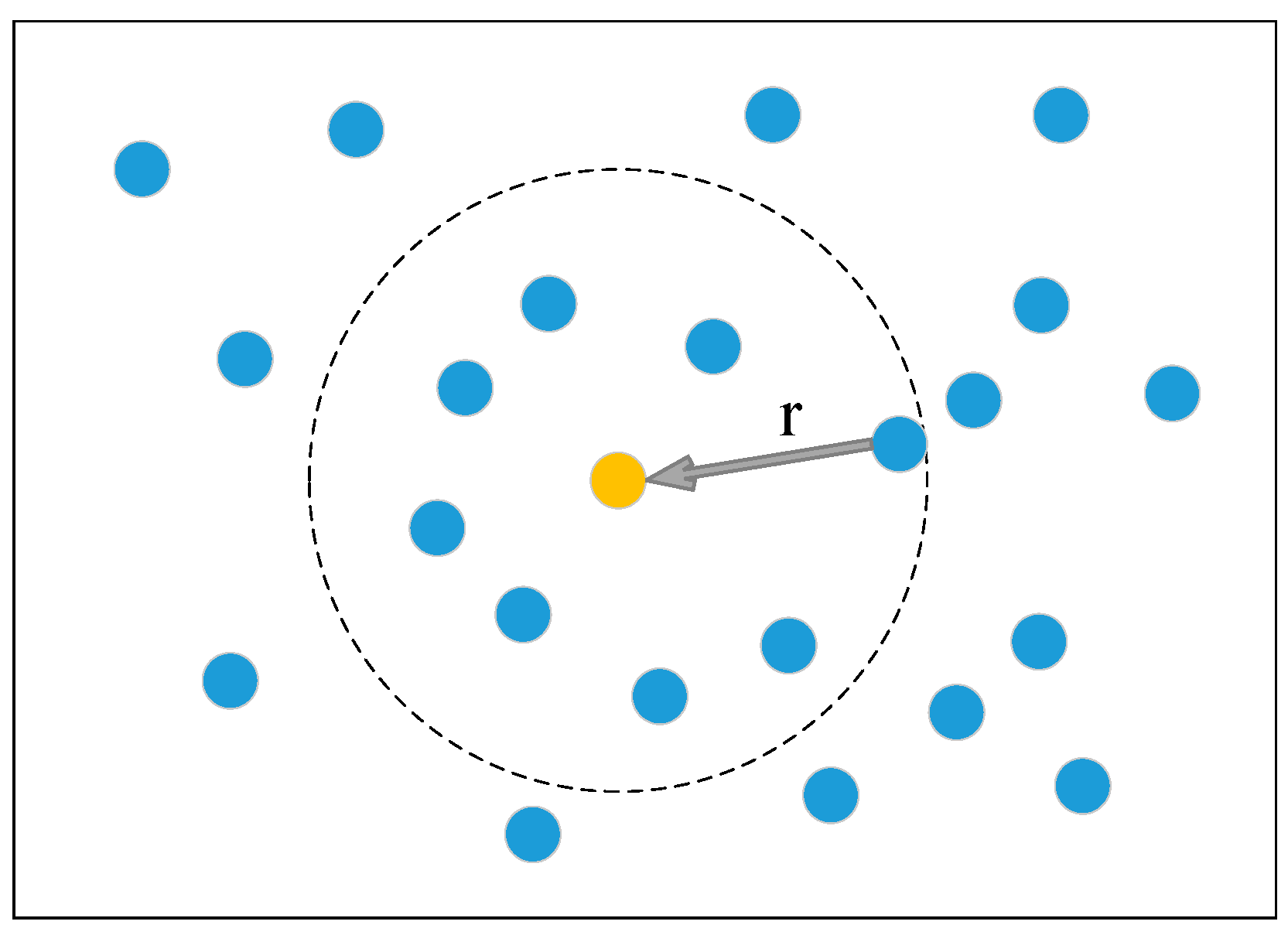
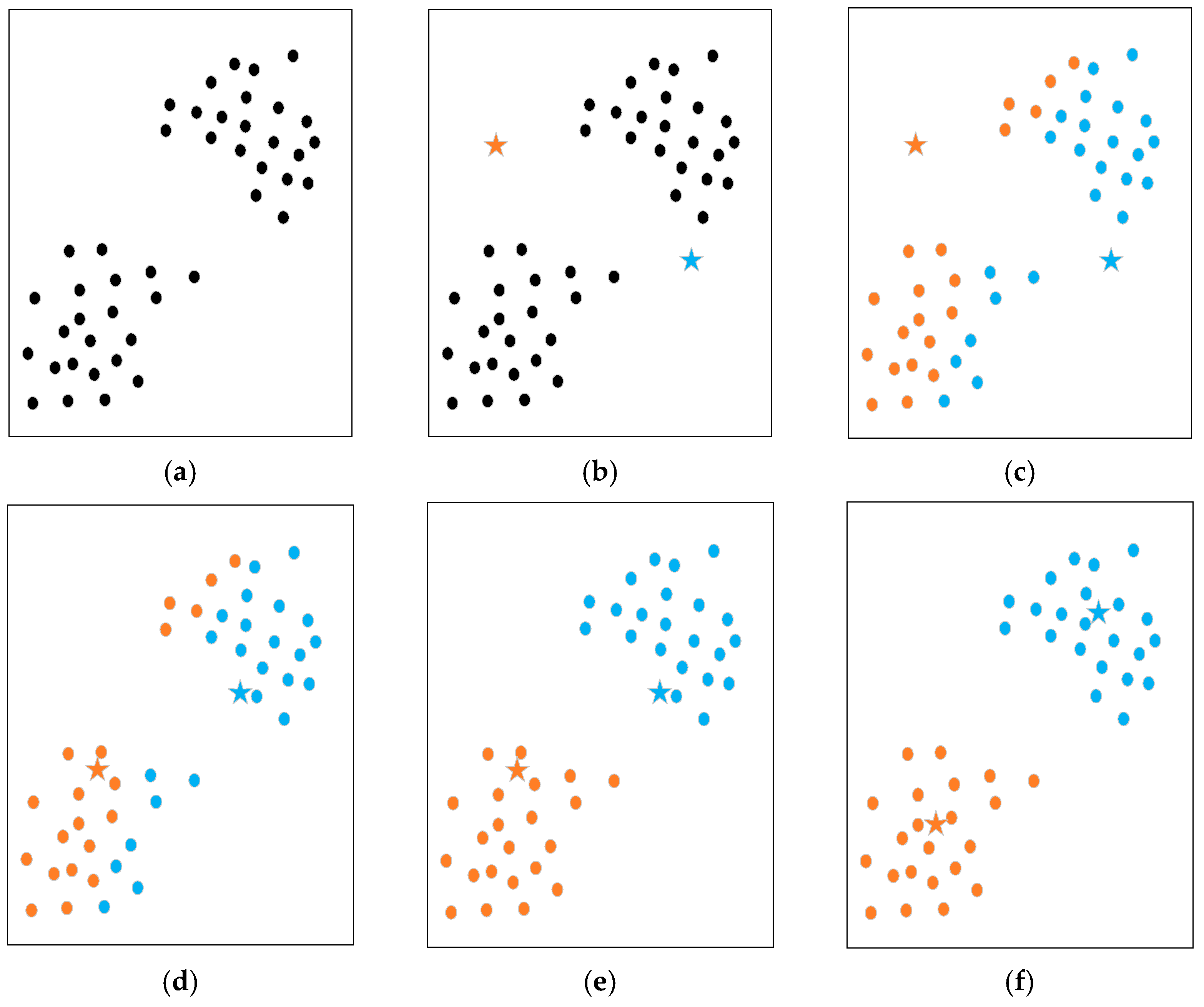
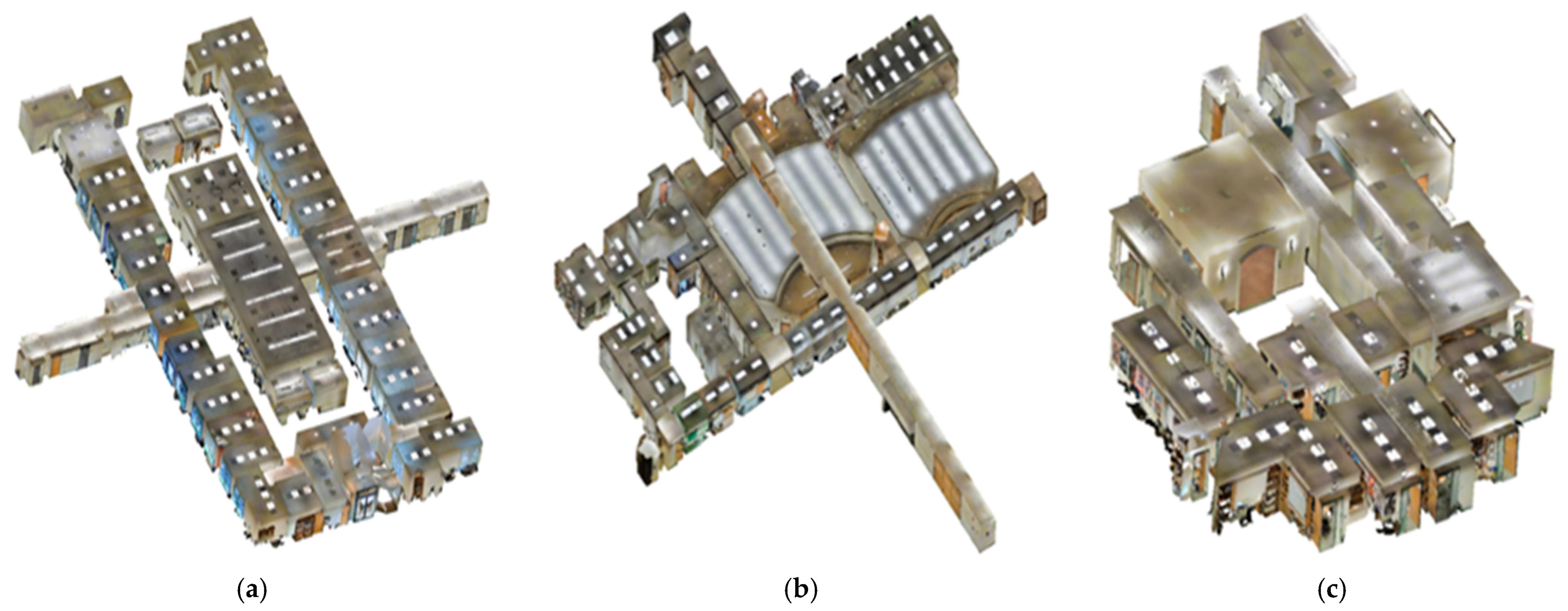
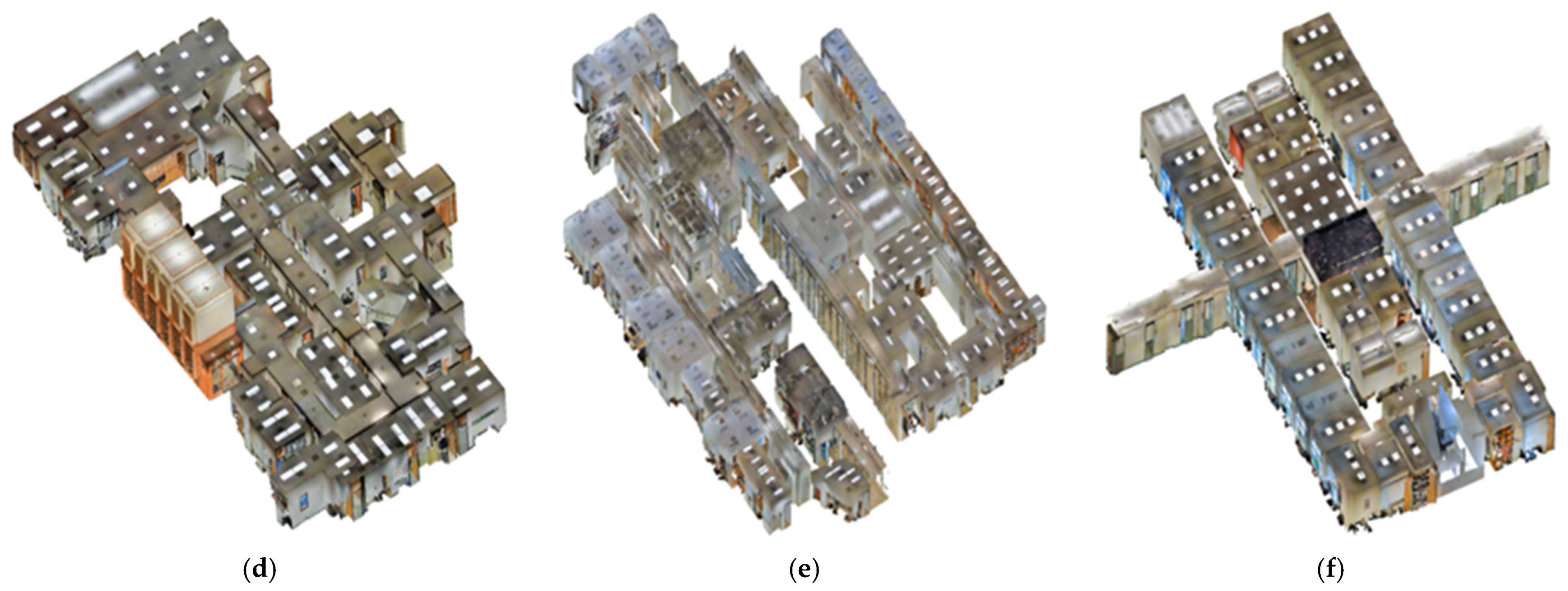
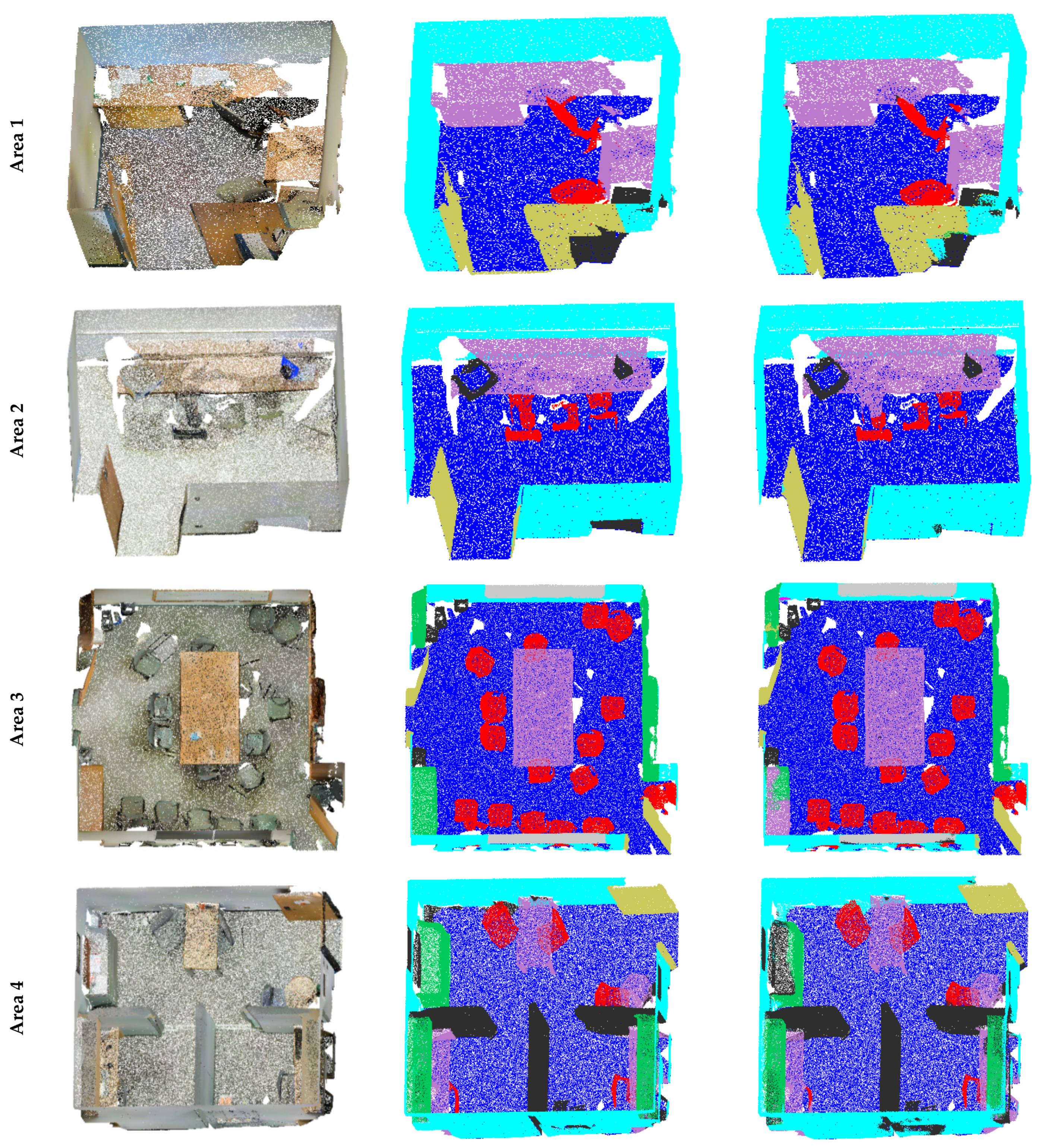
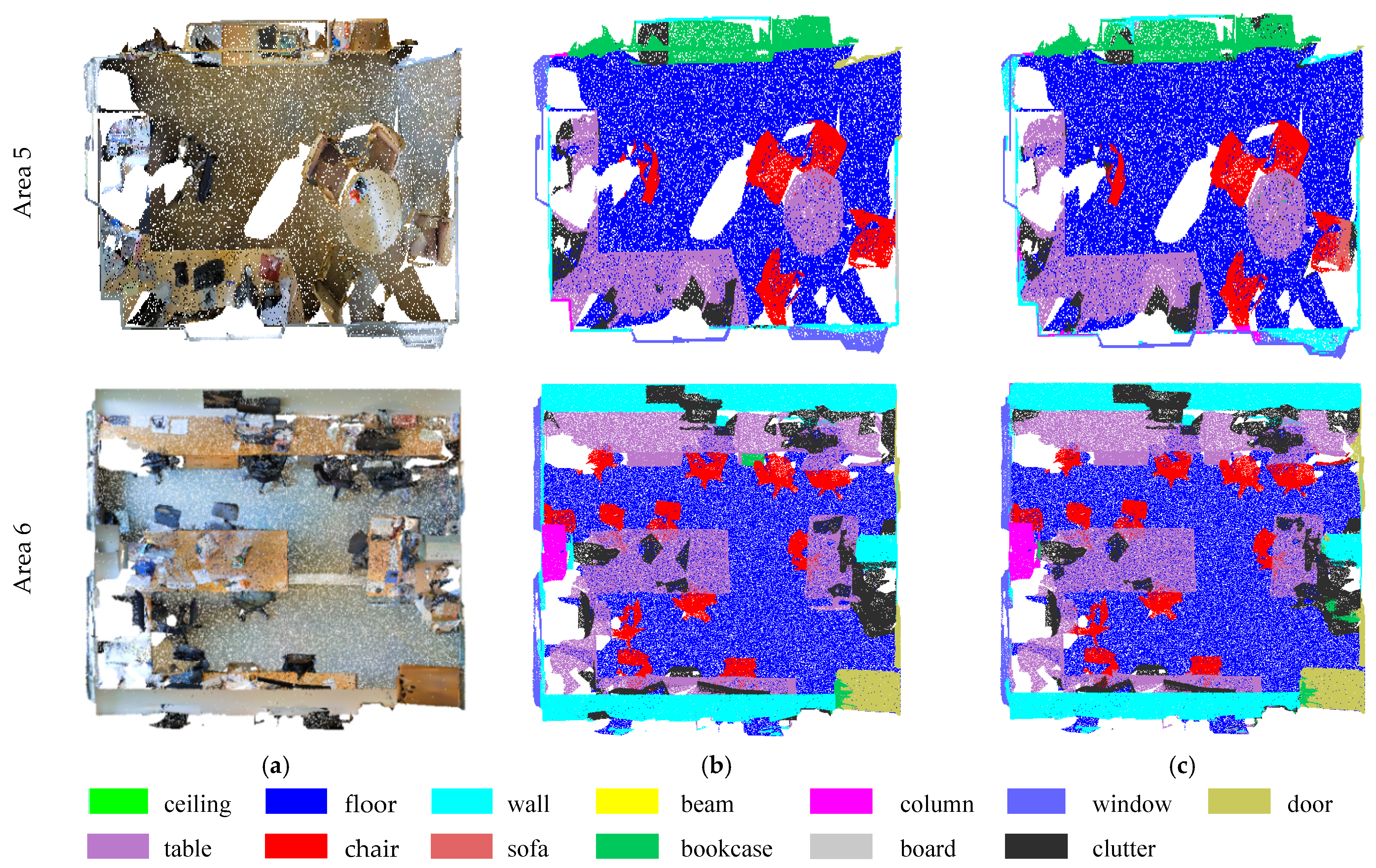
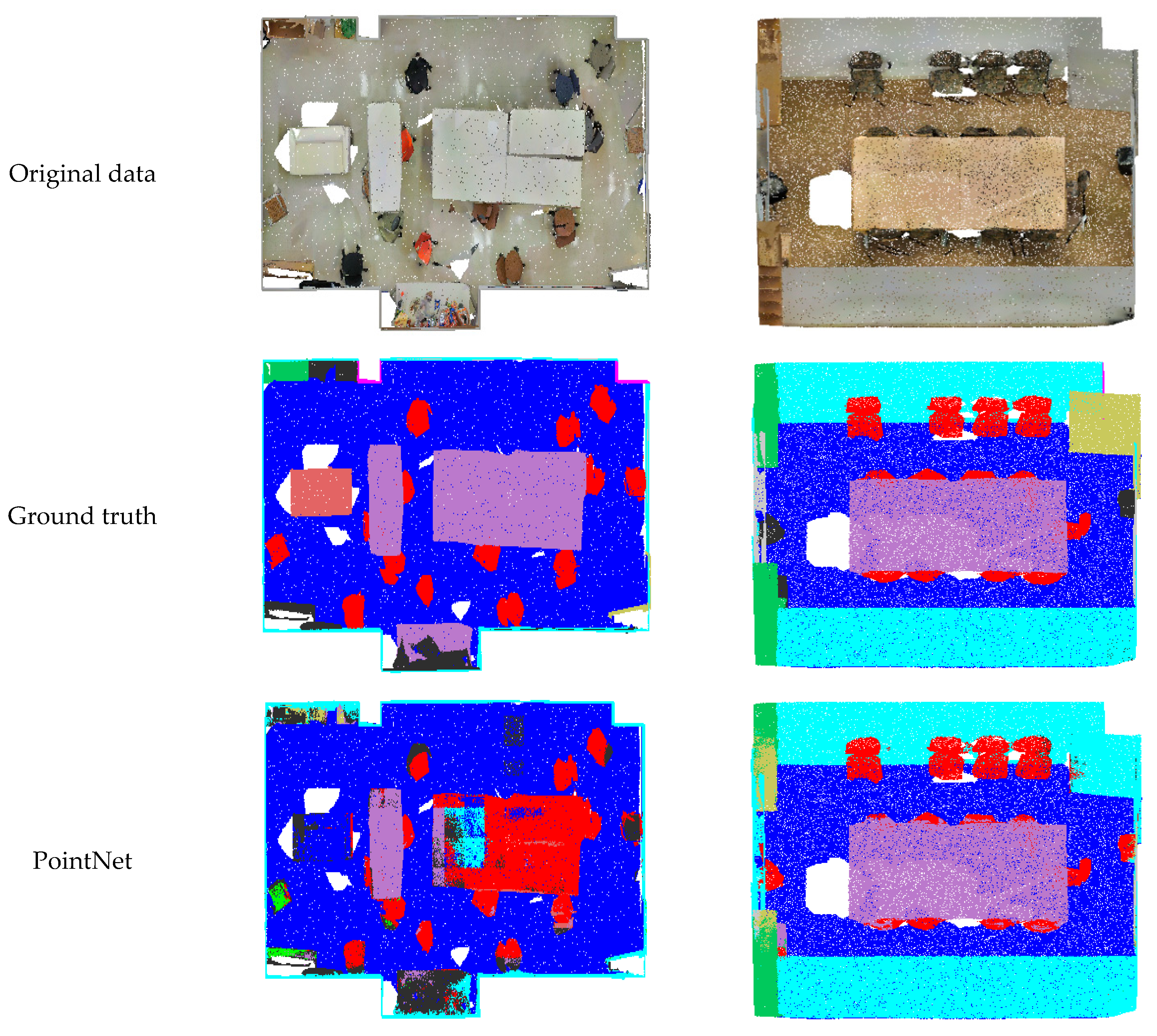
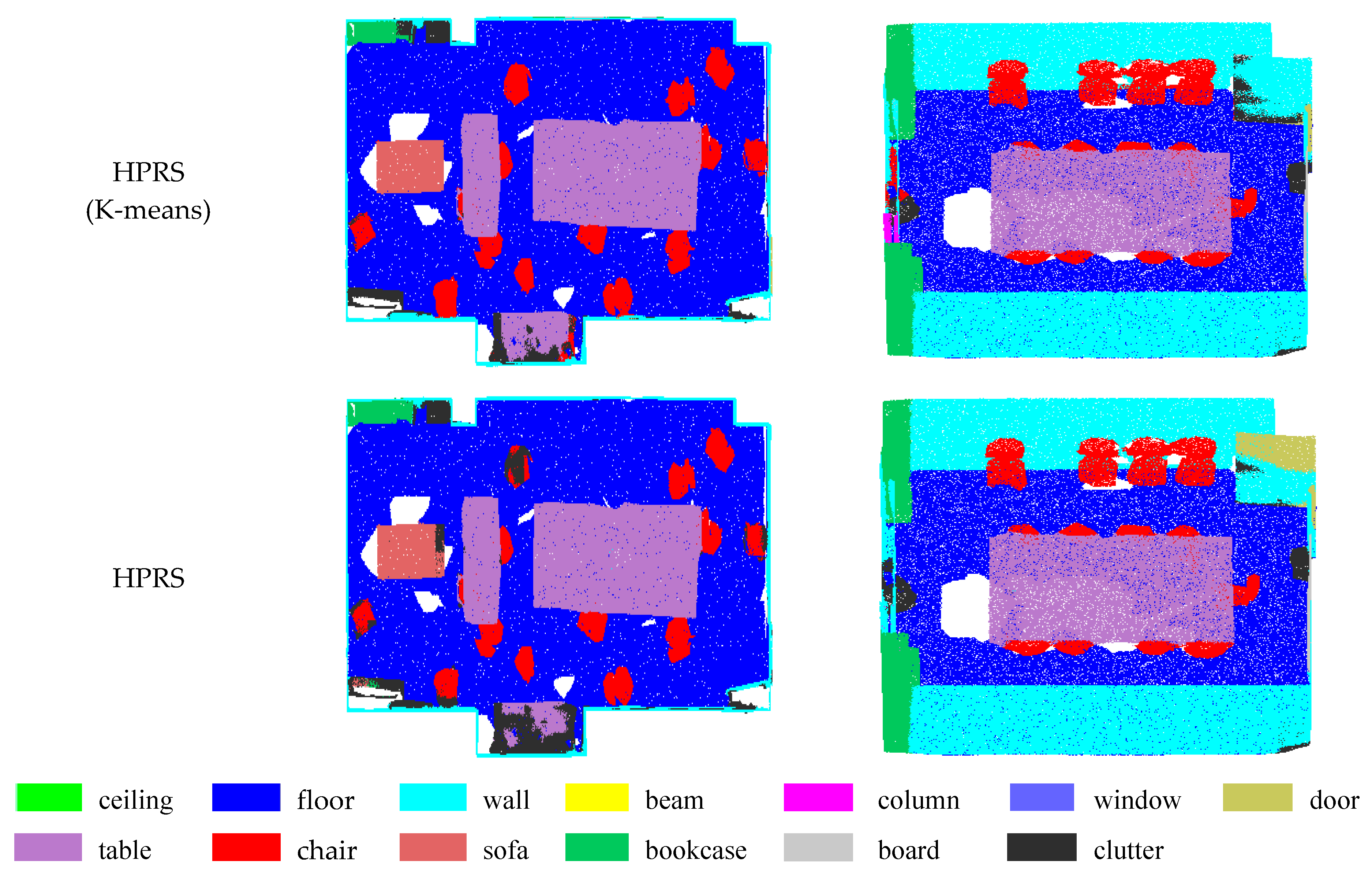
| The Number of Sampling Center Points | The Neighborhood Radius of Each Sampling Point (m) | The Number of Sampling Points in Each Ball Space | The Input Feature Dimension | The Neuron Numbers for Each Layer | |
|---|---|---|---|---|---|
| SA1 | 1024 | 0.05 | 8 | 9 | (16,16,32) |
| 0.1 | 16 | (16,16,32) | |||
| SA2 | 512 | 0.1 | 8 | 32 + 32 | (32,32,64) |
| 0.2 | 16 | (32,32,64) | |||
| SA3 | 256 | 0.2 | 8 | 64 + 64 | (64,64,96) |
| 0.4 | 16 | (64,64,96) | |||
| SA4 | 128 | 0.4 | 16 | 96 + 96 | (96,96,128) |
| 0.6 | 32 | (96,96,128) | |||
| SA5 | 64 | 0.6 | 16 | 128 + 128 | (128,196,256) |
| 0.8 | 32 | (128,196,256) | |||
| SA6 | 32 | 0.8 | 16 | 256 + 256 | (256,384,512) |
| 1.0 | 32 | (256,384,512) |
| FP1 | FP2 | FP3 | FP4 | FP5 | FP6 | |
|---|---|---|---|---|---|---|
| The input feature dimension | 128 | 32 + 32 + 196 | 64 + 64 + 196 | 96 + 96 + 256 | 128 + 128 + 256 | 512 + 512 + 256 + 256 |
| The neuron numbers for each layer | (128,128,128) | (128,196) | (196,256) | (196,256) | (256,256) | (256,256) |
| Area 1 | Area 2 | Area 3 | Area 4 | Area 5 | Area 6 | |
|---|---|---|---|---|---|---|
| OA | 85.10 | 77.67 | 88.89 | 82.16 | 84.12 | 90.24 |
| mAcc | 75.69 | 59.25 | 84.91 | 63.62 | 64.76 | 80.01 |
| mIoU | 65.61 | 43.76 | 73.69 | 51.90 | 56.66 | 76.45 |
| ceiling | 93.3 | 90.9 | 95.4 | 90.5 | 89.9 | 96.2 |
| floor | 95.1 | 80.4 | 98.5 | 97.3 | 98.0 | 97.8 |
| wall | 73.2 | 74.7 | 78.4 | 76.0 | 74.3 | 81.3 |
| beam | 25.6 | 13.6 | 62.6 | 0.0 | 0.0 | 79.1 |
| column | 34.3 | 24.1 | 14.9 | 18.8 | 8.5 | 52.5 |
| window | 79.6 | 42.5 | 81.9 | 31.0 | 63.6 | 80.0 |
| door | 80.1 | 52.9 | 80.0 | 47.8 | 24.5 | 85.7 |
| table | 69.0 | 48.4 | 71.7 | 57.1 | 71.7 | 75.9 |
| chair | 76.0 | 35.8 | 82.7 | 60.9 | 81.5 | 79.1 |
| sofa | 52.0 | 6.1 | 72.3 | 48.0 | 47.1 | 56.5 |
| bookcase | 50.1 | 41.0 | 67.7 | 47.0 | 66.0 | 64.8 |
| board | 62.8 | 20.3 | 84.9 | 48.7 | 65.5 | 78.6 |
| clutter | 61.7 | 38.0 | 67.1 | 51.5 | 46.0 | 66.4 |
| PointNet | PointNet++ | G+RCU | RSNet | 3P-RNN | DPFA | HPRS | |
|---|---|---|---|---|---|---|---|
| OA | 78.5 | 80.9 | 81.1 | - | 86.9 | 89.01 | 84.70 |
| mAcc | 66.2 | - | 66.4 | 66.45 | 73.6 | - | 72.71 |
| mIoU | 47.6 | 53.2 | 49.7 | 56.47 | 56.3 | 61.61 | 61.35 |
| ceiling | 88.0 | 90.2 | 90.3 | 92.48 | 92.9 | 94.61 | 92.70 |
| floor | 88.7 | 91.7 | 92.1 | 92.83 | 93.8 | 97.68 | 94.52 |
| wall | 69.3 | 73.1 | 67.9 | 78.56 | 73.1 | 77.84 | 76.32 |
| beam | 42.4 | 42.7 | 44.7 | 32.75 | 42.5 | 38.45 | 30.15 |
| column | 23.1 | 21.2 | 24.2 | 34.37 | 25.9 | 38.28 | 25.52 |
| window | 47.5 | 49.7 | 52.3 | 51.62 | 47.6 | 53.34 | 63.10 |
| door | 51.6 | 42.3 | 51.2 | 68.11 | 59.2 | 67.66 | 61.83 |
| table | 54.1 | 62.7 | 58.1 | 60.13 | 60.4 | 66.60 | 65.63 |
| chair | 42.0 | 59.0 | 47.4 | 59.72 | 66.7 | 75.23 | 69.33 |
| sofa | 9.6 | 19.6 | 6.9 | 50.22 | 24.8 | 29.48 | 47.00 |
| bookcase | 38.2 | 45.8 | 39.0 | 16.42 | 57.0 | 49.79 | 56.10 |
| board | 29.4 | 38.2 | 30.0 | 44.85 | 36.7 | 51.38 | 60.13 |
| clutter | 35.2 | 45.6 | 41.9 | 52.03 | 51.6 | 60.64 | 55.12 |
| PointNet | SEGCloud | DGCNN | RSNet | TangenConv | PointCNN | HPRS (K-Means) | HPRS | |
|---|---|---|---|---|---|---|---|---|
| OA | - | - | - | - | 82.5 | 85.91 | 83.10 | 84.12 |
| mAcc | 48.98 | 57.35 | 59.8 | 59.42 | 62.2 | 63.86 | 66.09 | 64.76 |
| mIoU | 41.09 | 48.92 | 51.5 | 51.93 | 52.8 | 57.26 | 56.45 | 56.66 |
| ceiling | 88.80 | 90.06 | 93.0 | 93.34 | 90.5 | 92.31 | 90.6 | 89.9 |
| floor | 97.33 | 96.05 | 97.4 | 98.36 | 97.7 | 98.24 | 97.8 | 98.0 |
| wall | 69.80 | 69.86 | 77.7 | 79.18 | 74.0 | 79.41 | 73.6 | 74.3 |
| beam | 0.05 | 0.00 | 0.0 | 0.00 | 0.0 | 0.00 | 0.0 | 0.0 |
| column | 3.92 | 18.37 | 12.2 | 15.75 | 20.7 | 17.60 | 10.7 | 8.5 |
| window | 46.26 | 38.35 | 47.8 | 45.37 | 39.0 | 22.77 | 60.8 | 63.6 |
| door | 10.76 | 23.12 | 39.8 | 50.10 | 31.3 | 62.09 | 22.0 | 24.5 |
| table | 58.93 | 70.40 | 67.4 | 67.87 | 77.5 | 74.39 | 73.8 | 71.7 |
| chair | 52.61 | 75.89 | 72.4 | 65.52 | 69.4 | 80.59 | 79.1 | 81.5 |
| sofa | 5.85 | 40.88 | 23.2 | 52.45 | 57.3 | 31.67 | 60.0 | 47.1 |
| bookcase | 40.28 | 58.42 | 52.3 | 22.45 | 38.5 | 66.67 | 64.0 | 66.0 |
| board | 26.38 | 12.96 | 39.8 | 41.02 | 48.8 | 62.05 | 57.7 | 65.5 |
| clutter | 33.22 | 41.60 | 46.6 | 43.64 | 39.8 | 56.74 | 43.7 | 46.0 |
| HPRS (The Common Ball Query Algorithm) | HPRS (The Adaptive Ball Query Algorithm) | |
|---|---|---|
| OA | 83.17 | 84.12 |
| mAcc | 63.73 | 64.76 |
| mIoU | 54.79 | 56.66 |
| ceiling | 90.8 | 89.9 |
| floor | 97.8 | 98.0 |
| wall | 73.7 | 74.3 |
| beam | 0.0 | 0.0 |
| column | 5.7 | 8.5 |
| window | 57.9 | 63.6 |
| door | 18.9 | 24.5 |
| table | 67.1 | 71.7 |
| chair | 78.8 | 81.5 |
| sofa | 57.4 | 47.1 |
| bookcase | 61.3 | 66.0 |
| board | 56.7 | 65.5 |
| clutter | 46.1 | 46.0 |
| HPRS (Mean Pooling) | HPRS (Max Pooling) | HPRS (Max Pooling and Mean Pooling) | |
|---|---|---|---|
| OA | 82.49 | 82.95 | 84.12 |
| mAcc | 59.38 | 61.61 | 64.76 |
| mIoU | 51.10 | 53.30 | 56.66 |
| ceiling | 92.1 | 90.1 | 89.9 |
| floor | 98.1 | 96.5 | 98.0 |
| wall | 72.6 | 74.6 | 74.3 |
| beam | 0.0 | 0.0 | 0.0 |
| column | 2.0 | 6.7 | 8.5 |
| window | 50.9 | 57.0 | 63.6 |
| door | 14.7 | 7.7 | 24.5 |
| table | 66.4 | 70.0 | 71.7 |
| chair | 81.4 | 81.5 | 81.5 |
| sofa | 34.6 | 46.9 | 47.1 |
| bookcase | 59.2 | 62.3 | 66.0 |
| board | 47.2 | 57.5 | 65.5 |
| clutter | 45.2 | 42.2 | 46.0 |
Publisher’s Note: MDPI stays neutral with regard to jurisdictional claims in published maps and institutional affiliations. |
© 2022 by the authors. Licensee MDPI, Basel, Switzerland. This article is an open access article distributed under the terms and conditions of the Creative Commons Attribution (CC BY) license (https://creativecommons.org/licenses/by/4.0/).
Share and Cite
Su, Z.; Zhou, G.; Luo, F.; Li, S.; Ma, K.-K. Semantic Segmentation of 3D Point Clouds Based on High Precision Range Search Network. Remote Sens. 2022, 14, 5649. https://doi.org/10.3390/rs14225649
Su Z, Zhou G, Luo F, Li S, Ma K-K. Semantic Segmentation of 3D Point Clouds Based on High Precision Range Search Network. Remote Sensing. 2022; 14(22):5649. https://doi.org/10.3390/rs14225649
Chicago/Turabian StyleSu, Zhonghua, Guiyun Zhou, Fulin Luo, Shihua Li, and Kai-Kuang Ma. 2022. "Semantic Segmentation of 3D Point Clouds Based on High Precision Range Search Network" Remote Sensing 14, no. 22: 5649. https://doi.org/10.3390/rs14225649
APA StyleSu, Z., Zhou, G., Luo, F., Li, S., & Ma, K.-K. (2022). Semantic Segmentation of 3D Point Clouds Based on High Precision Range Search Network. Remote Sensing, 14(22), 5649. https://doi.org/10.3390/rs14225649










